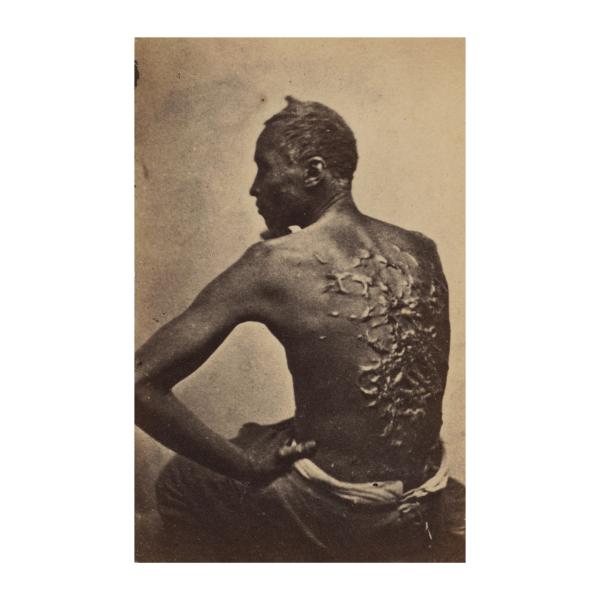Gordon, A Runaway Mississippi Slave, or "The Scourged Back"
Artwork Details
- Title: Gordon, A Runaway Mississippi Slave, or "The Scourged Back"
- Artist: McPherson & Oliver (American, active New Orleans and Baton Rouge, Louisiana, 1860s)
- Date: April 2, 1863
- Medium: Albumen silver print from glass negative
- Dimensions: Image: 3 1/2 × 2 3/16 in. (8.9 × 5.6 cm)
Sheet: 3 1/2 × 2 3/16 in. (8.9 × 5.6 cm)
Mount: 4 1/16 in. × 2 1/2 in. (10.3 × 6.3 cm)
Frame (approx): 14 x 11 in. - Classification: Photographs
- Credit Line: Purchase, Vital Projects Fund Inc. Gift, through Joyce and Robert Menschel, 2019
- Object Number: 2019.522
- Curatorial Department: Photographs
Audio

611. The Civil War: Capturing Slavery
Gordon, A Runaway Mississippi Slave, or “The Scourged Back,” March–April 1863
LUCY SANTE: The scourged back. What were they trying to show? Who were they trying to show it to?
NARRATOR: The man depicted here, Gordon, escaped from slavery in Mississippi. He made his way to a Union encampment in Baton Rouge, Louisiana and that’s where this photograph was made.
Here’s Makeda Best, photography historian and deputy director of curatorial affairs at the Oakland Museum in California.
MAKEDA BEST: What happened as soon as the Civil War started was that many people of African descent, enslaved people, wanted to do something.
So, they started showing up at the Union encampments. And there are stories all over Harper’s of the enslaved people who had come to Union lines with various instruments of torture attached to them, or with scars.
NARRATOR: Harper’s was a popular, weekly magazine which published an engraving of this photograph in July of 1863. It was featured in a story about Gordon and his transformation into a soldier.
BEST: People didn't just read the illustrated newspapers and throw them away, they shared them. These newspapers would be viewed by many people, a single issue.
NARRATOR: For those who had not witnessed the horrors of slavery firsthand…
BEST: To be able to see it in photography was something that was revelatory at the time, and shocking at the time. And these images were used by abolitionists.
NARRATOR: This image circulated widely, so that Gordon became a kind of symbol of the anti-slavery cause.
Today, scholars are asking complicated questions about images like this one:
BEST: Around what it means for us to look at horrible images, what it means for someone to make images that are really horrific, what are the rights of the sitter. And I think that rightly so, we’re beginning to think more about who these people are and not just what we see in this picture.
More Artwork
Research Resources
The Met provides unparalleled resources for research and welcomes an international community of students and scholars. The Met's Open Access API is where creators and researchers can connect to the The Met collection. Open Access data and public domain images are available for unrestricted commercial and noncommercial use without permission or fee.
To request images under copyright and other restrictions, please use this Image Request form.
Feedback
We continue to research and examine historical and cultural context for objects in The Met collection. If you have comments or questions about this object record, please contact us using the form below. The Museum looks forward to receiving your comments.